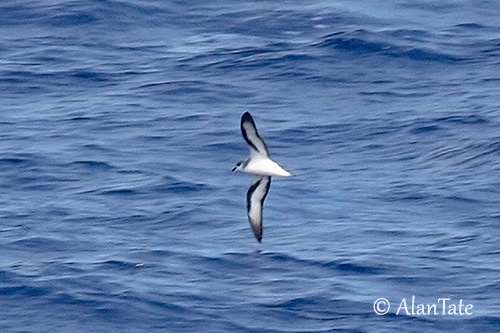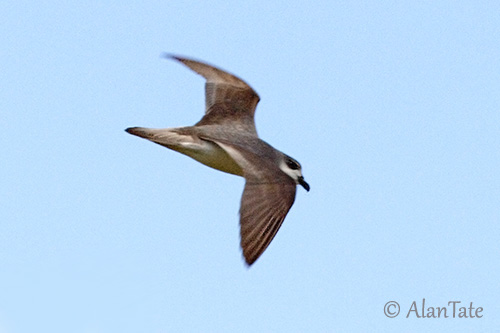
Fr: Pétrel à ailes noires - Diablotin à ailes noires
Ang: Black-winged Petrel
All: Schwarzflügel-Sturmvogel
Esp: Petrel Alinegro
Ita: Petrello alinere
Nd: Zwartvleugelstormvogel
Sd: kragpetrell
Photographers:
Alan & Ann Tate
AA Bird Photography
Text by Nicole Bouglouan
Sources:
HANDBOOK OF THE BIRDS OF THE WORLD vol 1 by Josep del Hoyo-Andrew Elliot-Jordi Sargatal - Lynx Edicions - ISBN: 8487334105
Petrels, Albatrosses, and Storm-Petrels of North America: A Photographic Guide De Steve N. G. Howell – Editor: Princeton University Press, 2012 – ISBN: 0691142114, 9780691142111 – 482pages
OISEAUX DE MER – Guide d’identification de Peter Harrison – Editions Broquet (Canada) – ISBN-10 : 2890004090 – ISBN-13 : 978-2890004092
Breeding biology of the Black-winged Petrel, Pterodroma nigripennis, on Lord Howe Island
Victoria University of Wellington
New Zealand birds and birding (Narena Olliver)
Lord Howe Island Biodiversity Management Plan
Wikipedia, the free encyclopaedia
Page family Procellariidae
Summary cards
Black-winged Petrel
Pterodroma nigripennis
Procellariiformes Order - Procellariidae Family
INTRODUCTION:
The Black-winged Petrel is a small gadfly petrel native to the East Pacific Ocean. It is highly pelagic and only comes to land for breeding on oceanic islands.
The nest-site is on sandy soil on a grassy slope inland. The birds excavate the tunnel or burrow with an entrance protected by bushes.
It feeds on cephalopods and prawns, and occasionally takes aquatic insects.
The Black-winged Petrel is globally one of the most numerous Pterodroma species, mainly common in offshore waters and islands of the Tasman Sea.
It is threatened by volcanoes on some breeding islands, but also by predators such as cats and rats, involving population decline. But currently, the Black-winged Petrel is not globally threatened.
DESCRIPTION OF THE BIRD:
Biometrics:
Length: 28-30 cm
Wingspan: 63-71 cm
Weight: 131-228 gr
The Black-winged Petrel is mostly grey above and white below, with conspicuous black-and-white pattern on the underwing, giving the bird its name.
The upperparts are grey, often paler on hindneck. We can see a blackish bar across the lower back. Rump and uppertail-coverts are pale grey and the tail is blackish.
The upperwing is mostly black, but depending on feather-wear and lighting, the secondaries, inner primaries and adjacent covert panels may appear pale and forming a distinct M across the back. However, this pattern is often less distinct than in closely related species.

The underparts are white, but the white underwing shows a broad, dark trailing edge on the flight-feathers and a conspicuous blackish band on carpal, and from carpal angle to central inner wing.
A large grey patch is visible on neck sides, forming sometimes an almost complete collar from which some vermiculations may sometimes extend to the body sides, just below the axillaries.
The white undertail shows a contrasting blackish tip.
The head is pale grey with darker to blackish mark through the eye. A narrow, indistinct white supercilium is visible above the eye. Lores, cheeks, head sides, chin and throat are white.
The bill is black. The eyes are blackish. Legs and base of webbed feet are usually pink, but occasionally blue. Rest of feet is greyish to blackish.
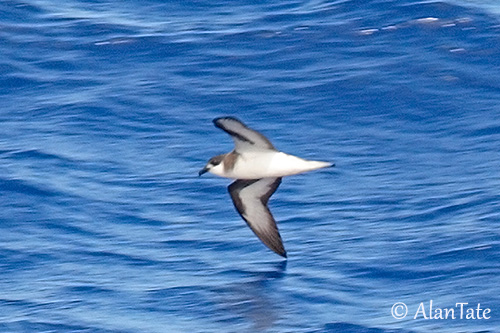
Male and female have similar plumage, but the female is slightly smaller than male.
The juvenile resembles adult with some small differences caused by unmoulted remiges during the first year.
RANGE:
The Black-winged Petrel breeds on islands of both Tasman Sea and Coral Sea, and E across Polynesia. It breeds in SW Pacific, from Lord Howe Island (Australia) and E Australia in the west, New Caledonia in the north, the Chatham Islands (New Zealand) in the south, and Austral Islands (French Polynesia) in the east.
The major part of the population breeds on New Zealand’s Kermadec Islands, with 2,000,000 to 3,000,000 pairs on Macauley Island and Curtis Island.
Outside of breeding season, most birds disperse widely north and east across the Pacific, mainly throughout Micronesia and Polynesia, N to the Philippine Sea, Ogasawara Islands and Hawaii, and also E to the distant offshore waters of Mexico and Ecuador.
HABITAT:
The Black-winged Petrel is marine and highly pelagic outside of breeding season. It comes to land to breed on oceanic islands. It is a colonial nester. The colonies are often established among low bushes or tussock grass, on high ground along cliff faces.
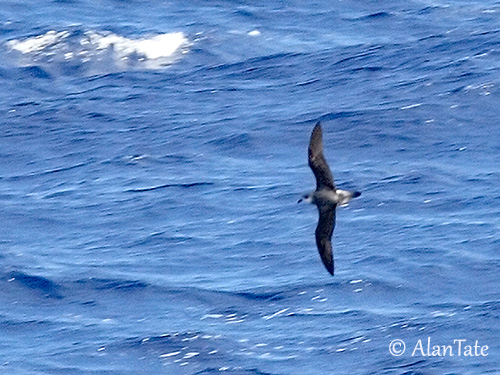
CALLS AND SONGS: SOUNDS BY XENO-CANTO
The calls of the Black-winged Petrel are high-pitched whistles described as “whis-whis-whis” or “wee-wee-wee” while flying. It also gives lower-pitched ground calls such as “ha-ha-ha”, and also a low “orrrrr”.
On the breeding grounds, we can hear various squeaks and wheezy whistles, usually given in quick series. And sometimes, it also gives thin, piping whistles.
BEHAVIOUR IN THE WILD:
The Black-winged Petrel feeds primarily on cephalopods and prawns, but it occasionally takes insects such as Sea skaters (Halobates). The prey are caught by surface-seizing and dipping, with also some pattering.
It is usually solitary, although it may sometimes forage with other Procellariidae species.
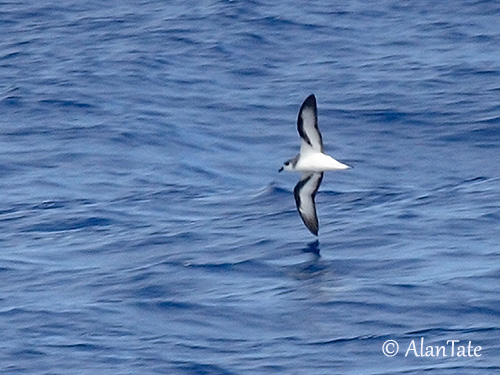
The Black-winged Petrel returns to the breeding sites where it breeds colonially on oceanic islands, usually remote islands.
The birds remain quiet until late November, and then, the colonies become noisy both day and night.
The petrels perform spectacular aerobatic courtship flights while calling loudly. The laying starts usually in late December. The eggs are laid in a tunnel excavated in sandy soil or sometimes placed in rock crevices. Both adults share the nesting duties.
Following the breeding season, the Black-winged Petrel disperses widely north and east across Pacific, generally from May to November. Most of them usually occur in a broad belt of ocean between Peru and Hawaii. A small part of the population may remain at sea year-round.
The Black-winged Petrel is very agile in flight, and performs aerobatic aerial displays accompanied by high-pitched calls.
At sea, it flies high while circling, and performs fast swooping low to the water.
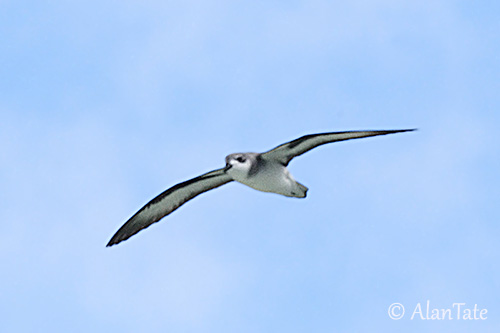
REPRODUCTION OF THIS SPECIES:
The Black-winged Petrel returns to the breeding sites between mid-October and late November, depending on the location. This species breeds in colonies and most birds breed annually.
The Black-winged Petrel nests in excavated burrow of 20-100 centimetres long, depending on the ground. The burrow is longer in sandy soil. The tunnel is lined with fresh leaves or litter. However, it may also nest in rock crevices.
The female lays a single, white egg. Both adults incubate during 45-46 days in shifts of 10-12 days. At hatching, the chick has grey down on face and upperparts, while the underparts are pale grey or white.
It is fed by both parents every 2-3 days during about 84-85 days. Then, the young bird leaves the burrow.
Most adults return to the colony to feed the chicks at night, arriving shortly after dusk. They fly swiftly and silently to their burrows to avoid predation.
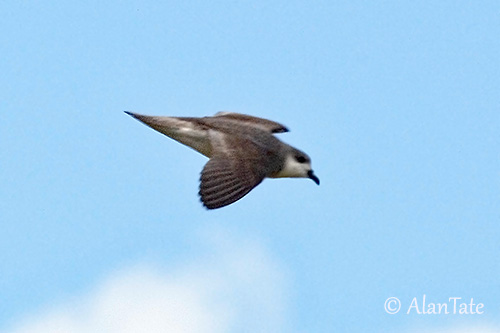
PROTECTION / THREATS / STATUS:
The Black-winged Petrel is vulnerable to predation by cats and rats, and on some islands, they are affected by the impact of feral pigs and goats.
The species is threatened by volcanoes, especially on Macauley Island where 2-3 million breeding pairs are nesting, and in some other locations too.
However, the introduced predators have been eradicated from several islands.
The size of the population is roughly estimated at 8,000,000/10,000,000 individuals. It is suspected to be declining, but the species is not considered globally threatened.
The Black-winged Petrel is currently evaluated as Least Concern.
